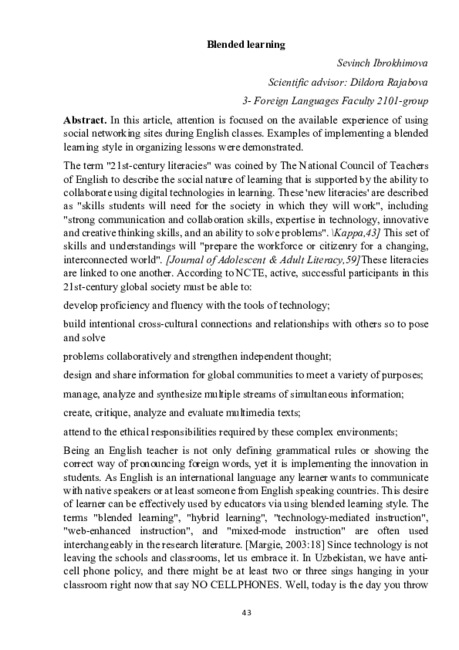
43
Blended learning
Sevinch Ibrokhimova
Scientific advisor: Dildora Rajabova
3- Foreign Languages Faculty 2101-group
Abstract.
In this article, attention is focused on the available experience of using
social networking sites during English classes. Examples of implementing a blended
learning style in organizing lessons were demonstrated.
The term "21st-century literacies" was coined by The National Council of Teachers
of English to describe the social nature of learning that is supported by the ability to
collaborate using digital technologies in learning. These 'new literacies' are described
as "skills students will need for the society in which they will work", including
"strong communication and collaboration skills, expertise in technology, innovative
and creative thinking skills, and an ability to solve problems".
\Kappa,43]
This set of
skills and understandings will "prepare the workforce or citizenry for a changing,
interconnected world".
[Journal of Adolescent & Adult Literacy,59]
These literacies
are linked to one another. According to NCTE, active, successful participants in this
21st-century global society must be able to:
develop proficiency and fluency with the tools of technology;
build intentional cross-cultural connections and relationships with others so to pose
and solve
problems collaboratively and strengthen independent thought;
design and share information for global communities to meet a variety of purposes;
manage, analyze and synthesize multiple streams of simultaneous information;
create, critique, analyze and evaluate multimedia texts;
attend to the ethical responsibilities required by these complex environments;
Being an English teacher is not only defining grammatical rules or showing the
correct way of pronouncing foreign words, yet it is implementing the innovation in
students. As English is an international language any learner wants to communicate
with native speakers or at least someone from English speaking countries. This desire
of learner can be effectively used by educators via using blended learning style. The
terms "blended learning", "hybrid learning", "technology-mediated instruction",
"web-enhanced instruction", and "mixed-mode instruction" are often used
interchangeably in the research literature. [Margie, 2003:18] Since technology is not
leaving the schools and classrooms, let us embrace it. In Uzbekistan, we have anti-
cell phone policy, and there might be at least two or three sings hanging in your
classroom right now that say NO CELLPHONES. Well, today is the day you throw

44
those things away.
Though cellphones are potential sources for distraction, they are also a piece of
technology that all know how to use (and students enjoy using) and one that you can
easily incorporate into your classroom. Odds are more than 80% of your students
have a cell phone.
Break from your lesson for a brainstorming session. Instruct your students to log into
their Facebook accounts. Tell them to post content relating to today’s lesson with a
hashtag so you can keep a track of who participated. (Example: #English #innovative
class)
They can also capture videos retelling the texts you have discussed during lesson and
upload in their YouTube accounts, or share their thoughts about class with photos on
Instagram.
Or you can send an interesting homework because the school bell rang in the middle
of your discussion and you wish you had just a few more minutes. Now you do.
Assign a video to watch or a set of questions to do online before the next class session.
(Tip: check first to see if all of your students have internet access outside of school
by conducting a survey.) You can send students the video link or worksheet in an
email or Telegram, and then your students can be prepared and ready for the class
discussion. For example, send a message to your students with the link to an online
documentary. Thanks to technology, you can now augment your lessons with
additional educational info.
By using a combination of digital instruction and one-on-one face time, students can
work on their own with new concepts that free teachers up to circulate and support
individual students who may need individualized attention.
A blended approach also helps teachers respond more easily to learners' different
styles by maximizing the strengths of each environment. It is easy for the teacher to
prepare programs of study that take into account such learning styles as:
visual or aural (i.e. preferring to use pictures, images, and sounds) through, for
example, watching videos/listening to audio
verbal (i.e. preferring to use language) through, for example, reading a text or asking
learners to prepare a spoken or written text
logical by, for example, using an inductive approach to grammar.
In our lessons, we have been teaching how to write a request letter or a complaint
letter to the students who have never opened his e-mail, in this current time in
Uzbekistan we are really in need of a blended learning approach to prepare students
to a very competitive job market. In Uzbekistan, we need an employee who knows
English and can represent their organization internationally.

45
Reference:
1.
Martyn, Margie (2003). "The hybrid online model: Good practice". Educause
Quarterly: 18-23.
2.
"21st Century Skills: Prepare Students for the Future". Kappa Delta Pi Record.
43.
3.
"The Challenge of 21st Century Literacies". Journal of Adolescent & Adult
Literacy. 59.
4.
"The NCTE Definition of 21st Century Literacies" (http://www .ncte. org
/positions /statements/21s)
5.
Палуанова,
Халифа
Дарибаевна.
"Экологик
терминларнинг
деривационсемантик хусусиятлари (ўзбек, қорақалпоқ, инглиз ва рус
тиллари мисолида). Филол. фан. д-ри.(DS)... дисс. автореф." Тошкент.-
2016 (2016).
6.
Палуанова,
Х.
Д.
"Экологик
терминларнинг
деривацион
хусусиятлари." Т.: Фан ва технология 152 (2016).






